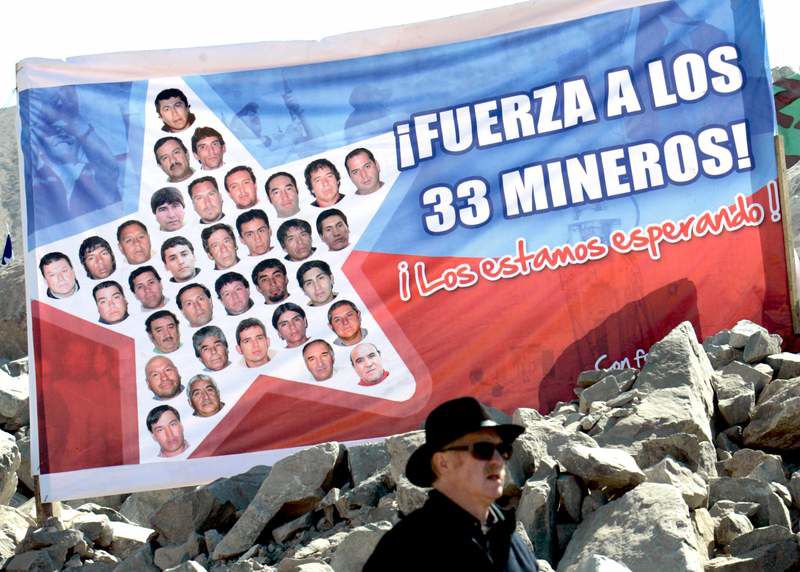Trapped miners may soon see sun
Published 5:00 am Saturday, October 9, 2010

- A man passes a banner printed with the portraits of the 33 trapped miners at the San Jose Mine in Chile's Atacama Desert. The miners may be rescued as soon as Tuesday, government officials say.
SAN JOSE MINE, Chile — After more than two months living nearly half a mile underground, 33 miners trapped below this scorching desert could be just a few days from emerging into what will seem like a blinding sun.
A powerful drill, twisting and pounding its way through the abrasive volcanic rock, was only about 130 feet from breaking through to the miners Friday afternoon, nearly completing a rescue hole for them to be hauled to the surface, according to Chile’s mining minister.
If all went well, he said, the drill could reach the miners early today.
But a rescue would still be days away, and officials here warned that the operation was entering its most dangerous phase. Every decision, they said, carried a risk that the inspiring story consuming the Chilean government and captivating the world could quickly turn toward disaster.
“We have done everything that technology permits,” said Miguel Fortt, a consultant on underground mining rescues in the Atacama region. “If the Lord doesn’t send us an earthquake, we’ll be OK.”
The miners themselves may have to set off dynamite to widen the hole at their end so that the rescue capsule — named the Phoenix — has enough room. Engineers at the surface also need to decide whether to line the rescue hole with steel pipes to prevent loose rocks from falling into the shaft and damaging or blocking the capsule.
But whatever the approach, it is going to be a very tight fit. The rescue hole is only a little more than 2 feet wide and it is not even straight, which could create potential snags as the capsule shimmies up, carrying one man at a time.
“There’s only about 2 inches clearance around it,” said John E. Urosek, chief of mine emergency operations for the U.S. Mine Safety and Health Administration. “And they’ll have to pull it out of that depth so many times, it could get wedged.”
Much of the uncertainty stems from how unusual the rescue effort is, turning it into a case study for experts around the world.
“The Chileans are really writing the book on this kind of rescue,” said Clint Cragg, an engineer who was part of a NASA delegation to the mine in September. “There haven’t been this many guys that deep for this long. It just hasn’t been done before.”
Laurence Golborne, the mining minister whose ubiquity during the crisis has made him a household name in Chile, said the rescue could begin as early as Tuesday. Lining the hole could set the schedule back further, but for some of the families waiting anxiously above, any delay in the name of safety is worthwhile.
“I prefer a thousand times that the process drags on two more days than to not line the hole,” said Maria Cortez, the sister-in-law of Mario Gomez, the oldest of the trapped miners. But lining the hole with tons of heavy steel pipes also presents a risk if they slip and fall, officials said.
Medical officials continue to prepare the miners for their moment in the sun. They have been keeping their weight under control so they can fit in the capsule, which is about 21 inches wide and built with suggestions from the NASA team. The men are also receiving media training to answer questions from the hundreds of reporters here at Camp Hope, the makeshift commune here where families have been living since the collapse Aug. 5.
After the drill breaks through, engineers will send down a camera to evaluate the hole and begin the process of prepping the rescue and capsule teams. But before any of the miners comes up, at least two rescuers will be sent down first, to stay in the mine and assist with the capsule.
Then there is the question of who is rescued first. The miners are being divided into three teams, Golborne said, depending on their physical and mental condition, and on their “skills.”
The first group to come up are likely to be the most talented and healthiest group, who will assist the rescuers at the top with the remainder of the operation. Among those will probably be Edison Pena, a fitness buff who has been running several kilometers a day inside the many winding tunnels still accessible to the trapped miners.
The second group will be the less physically fit, like Gomez, who has a lung condition and Jose Ojeda, who has diabetes. And then the rest will follow.
Once at the surface, the miners will receive wrap-around sunglass used by mountain climbers and surfers to protect against sudden exposure to the bright sun, and then be treated for first aid on site before being whisked by helicopters to a nearby hospital. Many of the miners have complained of dental pain and skin irritation that will require treatment when they emerge, officials said.
Rescuing the miners has become an obsession for President Sebastian Pinera and his government, which has spared no expense, technological consultation or innovation. Pinera’s approval rating has risen steadily since the miners were found after more than two weeks during which their fate was uncertain. And Golborne has become the most popular minister in the Pinera government, a recent opinion poll suggests.
Three efforts were organized to drill holes that could accommodate a rescue capsule. Known as Plans A, B, and C, they proceeded simultaneously. It was Plan B that was on the verge of breaking through to the trapped men on Friday, at a spot more than 2,050 feet below the surface — roughly twice as deep as the Empire State Building is tall.






